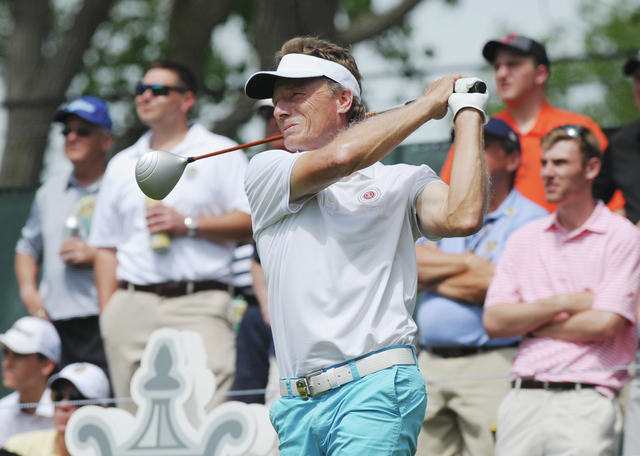Hilo’s Kevin Hayashi shot an 8-over-par 79 on Friday and missed the cut by nine strokes at the Senior PGA Championship, where the old folks are good.
Hilo’s Kevin Hayashi shot an 8-over-par 79 on Friday and missed the cut by nine strokes at the Senior PGA Championship, where the old folks are good.
Rocco Mediate is tearing up the golf course at Harbor Shores, Mich., where he fired a 5-under 66 for a 128 total and four-shot lead over Gene Sauers.
Most people know Mediate as the guy who lost to Tiger Woods for the 2008 U.S. Open on the first sudden-death playoff following an 18-hole extra inning affair.
That was Tiger’s 14th and last major at his Torrey Pines hometown course in La Jolla, Calif., leaving him four short of the Golden Bear’s 18.
Much has changed since then, not only on the PGA Tour, but also on the recently renamed PGA Tour Champions (yes, that’s the correct name, and it reads funny).
In 2002, the Senior Tour changed its name to the Champions Tour and underwent a makeover to put to bed the image of the 50-and-over crowd as geriatric golfers who drink Metamucil all day.
During his Senior Tour days, Hale Irwin was the dominant golfer when he joined the old-folks circuit in 1995. He is the career leader in wins and earnings with 45 victories and over $26 million.
Even the old Bear, Jack Nicklaus, played on the Senior Tour from 1990 to ’96 and won eight tournaments.
Local golf fans may remember Irwin well because in 1981 he won the Hawaiian Open (now called the Sony Open) by six strokes.
Hayashi is 53 years old, so he knows Irwin’s history.
Irwin collected 20 wins on the PGA Tour, including three U.S. Open titles, and distinguished himself on both tours (young guns and old guys).
Irwin is 70 years old and was inducted into the World Golf Hall of Fame in 1992.
Back in his golden days, Irwin was one of the fittest golfers and hit the ball farther than a lot of his senior citizen competitors.
Basically, Irwin was Tiger Woods, who not only hit the ball farther than his modern-day foes, but also changed the dynamics of the sport.
Wood introduced the type of training (mainly weight lifting, core strengthening, and not eating fast foods) reserved for other sports, like the NFL, NBA and Major League Baseball. The old joke is that golfers only stretched when picking up a candy bar off the floor.
Old Tiger was one of the longest drivers off the tee on Tour between 2004 and ’06, averaging 303.24 yards, according to PGA Tour stats.
However, others followed Woods’ regimen, and a lot of top-level golfers have their own management-assigned training programs, plus swing coaches, sports psychologists, and nutrition advisors.
Also, the golf club and ball technology have allowed much of the Tour to close the gap in distance off the tee. Everybody is playing with home-run drivers and paid quite handsomely to wear a company’s logo.
At the Senior PGA Championship, the field is stacked with the marketable-themed PGA Tour champions like Sauers (three PGA Tour wins), Bernhard Langer (three), Tom Lehman (five), Kenny Perry (14), former Tiger pal Mark O’Meara (16), and Lee Janzen (eight) and so forth.
It makes sense for those old-timers to play on the PGA Tour Champions to add to their social security income, rather than compete against the big hitters on the PGA Tour.
One well-known PGA Tour champion name on the cut list was Tom Kite (19, including the 1992 U.S. Open).
Kite, he of the thick glasses and not to be confused with cranky Tom Watson, finished with a 73-72—145 total.
The 66-year-old Kite missed the cut by three shots, in part because of a dusty PGA Tour slogan, “These guys are good,” that also applies to the old folks as well.




